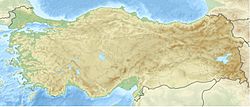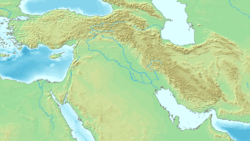Norşuntepe facts for kids
Norşuntepe is an ancient mound where people lived a long, long time ago. It's located in Elazığ Province in Turkey. A "tell" is like a big hill made up of many layers of old towns and villages built one on top of another over thousands of years.
People lived at Norşuntepe from the Chalcolithic period (which was the Copper Age) all the way through the Iron Age. Today, part of this ancient site is underwater because of Lake Keban. Archaeologists, who are like history detectives, dug up the site between 1968 and 1974 to learn about its past before more of it was covered by water.
| Location | Elazığ Province, Turkey |
|---|---|
| Coordinates | 38°37′8″N 39°28′12″E / 38.61889°N 39.47000°E |
| Altitude | 855 m (2,805 ft) |
| Type | tell, cemetery, human settlement |
| Length | 800 metre |
| Width | 600 metre |
| Area | 8.2 hectare |
| Height | 35 metre |
| History | |
| Periods | Chalcolithic, Early Bronze Age, Early Iron Age, Middle Ages |
| Site notes | |
| Excavation dates | 1968–1974 |
| Archaeologists | {{#statements:P4345}} |
| Condition | flooded |
Contents
Norşuntepe's Location and Size
Before it was flooded, Norşuntepe was located on a flat area called the Altınova Plain. It was near where the Murat River flows. Now, the top part of the site is still above the water of the Keban Dam's reservoir.
The site has a main hill, like a central fortress, which is about 140 meters long and 100 meters wide. It stands about 35 meters high, making it the biggest ancient mound in that area. Around this central hill, there were lower areas that spread out over a space of about 800 meters by 600 meters.
A Long History of Settlement
Norşuntepe was a busy place for a very long time, from the Copper Age (Chalcolithic) to the Iron Age. Archaeologists found evidence of 40 different times people lived there, one on top of the other! This means people kept building new homes and villages on the same spot for thousands of years, from around 5000 BC to about 600 BC. The history of Norşuntepe is very similar to another nearby ancient site called Arslantepe.
The Copper Age (Chalcolithic Period)
The Copper Age at Norşuntepe can be split into three main parts. The earliest part, Phase I, had pottery that looked like the Ubaid style from Mesopotamia (modern-day Iraq). In the later part of the Copper Age (Phase II), the buildings found by archaeologists became more complex.
Early Metalworking
During Phase II of the Copper Age, people at Norşuntepe were making things out of copper and a special metal called arsenical bronze. This was a very early time for making arsenical bronze in this region, even before 4000 BC! It shows that people here knew how to mix arsenic with copper on purpose to make a stronger metal.
Archaeologists found evidence of this metalworking in the same layers where they found Ubaid-style pottery. This suggests there were connections to Mesopotamian building styles too. Another nearby site from the same time, Değirmentepe, also made arsenic-bronze around 4200 BC.
The very last parts of the Copper Age at Norşuntepe had small houses with just one room. Scientists used radiocarbon dating to figure out that these Copper Age levels date back to between 4300 and 3800 BC.
The Early Bronze Age
After a break, people returned to Norşuntepe during the Early Bronze Age. The site grew quite large, covering about 3.2 hectares (about 8 acres) in the early parts of this period. Later, it became smaller, shrinking to about 0.8 hectares.
During the Early Bronze Age, the settlement was protected by a city wall made of mudbrick built on a stone base. There's also proof that people were making copper here. In the final stages of this period, a large building, possibly a palace or a central community building, appeared at the site. The way people built and the things they made during this time show clear connections to the Transcaucasia region and a culture called the Kura–Araxes culture. The Early Bronze Age at Norşuntepe ended with a big fire.
The Middle Bronze Age
The settlement during the Middle Bronze Age was smaller than the one before it. Archaeologists haven't found any evidence of a palace from this time.
The Late Bronze Age
The remains from the Late Bronze Age at Norşuntepe were quite mixed up by later activities from the Iron Age. However, archaeologists still managed to find some larger buildings from this period.
The Iron Age
The early Iron Age at Norşuntepe (around 1150–800 BC) saw a change in culture. Things no longer looked like the Hittite style. This might have happened because new groups of people, like the Mushki, moved into the area. During this time, the settlement seemed to be mostly on the south terrace and might have been more like a small village or farming community.
In its final years (800–600 BC), Norşuntepe became part of the powerful kingdom of Urartu. A large building with many columns was found on the main hill. Another big building, possibly a caravanserai (a roadside inn for travelers), was found on the south terrace. Archaeologists also discovered a cemetery (a burial ground) on the hilltop. Inside one burial chamber, they found three horses buried with their gear and weapons!
The hilltop was used as a cemetery again much later, during the Medieval Period.
Digging Up the Past
Norşuntepe was excavated between 1968 and 1974. The digs were led by a German archaeologist named Harald Hauptmann. This was part of a "salvage project" to save and record ancient sites that were going to be flooded by the building of the Keban Dam. The archaeologists focused their digging on three main areas: the western slope, the central "acropolis" hill, and the south terrace.



